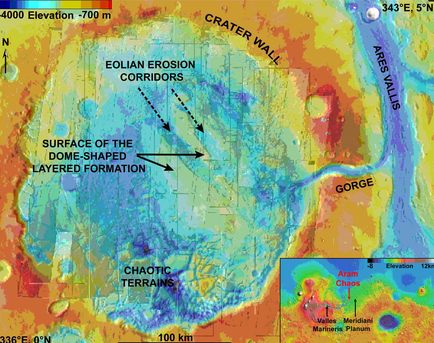Mars Express
Mars Express zeros in on erosion features
Mars Express has uncovered geological evidence suggesting that some depositional process, revealed by erosion, has been at work on large scales in the equatorial regions of the planet. If so, this would provide another jigsaw piece to be fitted into the emerging picture of Mars’ past climate.
 © NASA/MGS/MOLA/THEMIS
|
This map shows the Aram Chaos region of Mars - a crater 170 miles in diameter lying almost directly on the martian equator. In this region Mars Express found mineralogical evidence for large-scale deposits of ferric oxides helping to understand the climatic changes on Mars.
Article Content
- » 1 -
- » 2 -
Mineralogy lesson on Mars
The evidence comes from the mineralogical composition of the Aram Chaos region, a crater 170 miles in diameter lying almost directly on the martian equator. Data from Mars Express’ OMEGA instrument, the Visible and Infrared Mineralogical Mapping Spectrometer, has revealed that this region shows a significant amount of sulphates and ferric oxides. On Earth, ferric oxide is more commonly known as rust.Observations from Mars Express show that the bright red dust covering much of the planet is enriched in ferric oxides. Yet in the dark deposits of Aram Chaos, there is a four-fold increase in the spectral signature of ferric oxides, revealing a specific concentration mechanism. Ferric oxides are generally found with sulphates but, in this case, the lighter sulphates have been blown away, leaving the ferric oxides exposed.
“They have accumulated in dark deposits at the bottom of sulphate cliffs,” says Stéphane Le Mouélic, Université de Nantes, a member of the team who performed the investigation. This suggests that the ferric oxides have been uncovered by erosion before dropping to the base of the cliffs. The dunes in this region are also enriched in ferric oxides.
Mars Express
Mars Express zeros in on erosion features
Mars Express has uncovered geological evidence suggesting that some depositional process, revealed by erosion, has been at work on large scales in the equatorial regions of the planet. If so, this would provide another jigsaw piece to be fitted into the emerging picture of Mars’ past climate.
 © NASA/MGS/MOLA/THEMIS
|
This map shows the Aram Chaos region of Mars - a crater 170 miles in diameter lying almost directly on the martian equator. In this region Mars Express found mineralogical evidence for large-scale deposits of ferric oxides helping to understand the climatic changes on Mars.
Article Content
- » 1 -
- » 2 -
Mineralogy lesson on Mars
The evidence comes from the mineralogical composition of the Aram Chaos region, a crater 170 miles in diameter lying almost directly on the martian equator. Data from Mars Express’ OMEGA instrument, the Visible and Infrared Mineralogical Mapping Spectrometer, has revealed that this region shows a significant amount of sulphates and ferric oxides. On Earth, ferric oxide is more commonly known as rust.Observations from Mars Express show that the bright red dust covering much of the planet is enriched in ferric oxides. Yet in the dark deposits of Aram Chaos, there is a four-fold increase in the spectral signature of ferric oxides, revealing a specific concentration mechanism. Ferric oxides are generally found with sulphates but, in this case, the lighter sulphates have been blown away, leaving the ferric oxides exposed.
“They have accumulated in dark deposits at the bottom of sulphate cliffs,” says Stéphane Le Mouélic, Université de Nantes, a member of the team who performed the investigation. This suggests that the ferric oxides have been uncovered by erosion before dropping to the base of the cliffs. The dunes in this region are also enriched in ferric oxides.





